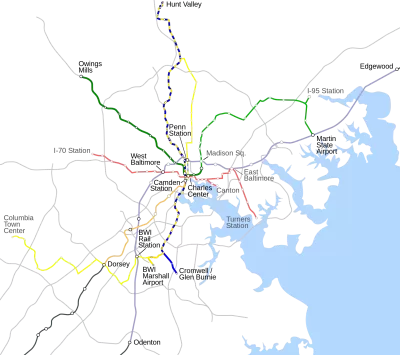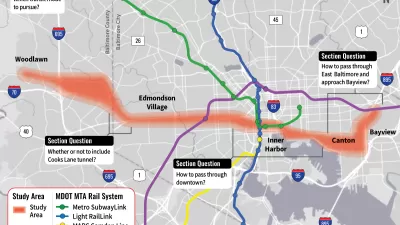The unique structure of the Maryland Transit Administration leaves local stakeholders out of decision-making.

A new report from the Eno Center for Transportation highlights the unique nature of the governance of Baltimore's transit system, the only one of the country's 50 largest state-run transit agencies to operate without a board of directors or local funding. Depending exclusively on federal and state funds, writes Alex Holt in Greater Greater Washington, makes Baltimore "uniquely vulnerable to the whims of each passing Maryland governor."
The report strongly recommends reform, emphasizing the importance of transit governance in determining a system's responsiveness to community needs. Governed by a single administrator, the Maryland Transit Administration (MTA) finds itself at a disadvantage when competing with other state agencies and regions (including the Washington, D.C. metropolitan area) for funding and support. The structure also gives the governor the power to make important decisions about local transit without additional oversight. With transit projects often needing up to a decade to get off the ground, leaving decisions up to governors means many projects get scrapped or forgotten as administrations change.
To remedy the situation, the report presents three possible solutions modeled on Boston, Pittsburgh, and Minneapolis. The suggestions include establishing transit oversight boards, installing a state-level board of directors, and forming a new, more comprehensive transit authority that includes funding and representation from multiple jurisdictions. While some solutions are faster and cheaper than others, the Eno Center report makes clear that the MTA needs drastic reform and more local control in order to effectively serve Baltimore's citizens.
FULL STORY: MTA’s transit governance isn’t working for Baltimore, a new report says

Study: Maui’s Plan to Convert Vacation Rentals to Long-Term Housing Could Cause Nearly $1 Billion Economic Loss
The plan would reduce visitor accommodation by 25,% resulting in 1,900 jobs lost.

North Texas Transit Leaders Tout Benefits of TOD for Growing Region
At a summit focused on transit-oriented development, policymakers discussed how North Texas’ expanded light rail system can serve as a tool for economic growth.

Why Should We Subsidize Public Transportation?
Many public transit agencies face financial stress due to rising costs, declining fare revenue, and declining subsidies. Transit advocates must provide a strong business case for increasing public transit funding.

How to Make US Trains Faster
Changes to boarding platforms and a switch to electric trains could improve U.S. passenger rail service without the added cost of high-speed rail.

Columbia’s Revitalized ‘Loop’ Is a Hub for Local Entrepreneurs
A focus on small businesses is helping a commercial corridor in Columbia, Missouri thrive.

Invasive Insect Threatens Minnesota’s Ash Forests
The Emerald Ash Borer is a rapidly spreading invasive pest threatening Minnesota’s ash trees, and homeowners are encouraged to plant diverse replacement species, avoid moving ash firewood, and monitor for signs of infestation.
Urban Design for Planners 1: Software Tools
This six-course series explores essential urban design concepts using open source software and equips planners with the tools they need to participate fully in the urban design process.
Planning for Universal Design
Learn the tools for implementing Universal Design in planning regulations.
City of Santa Clarita
Ascent Environmental
Institute for Housing and Urban Development Studies (IHS)
City of Grandview
Harvard GSD Executive Education
Toledo-Lucas County Plan Commissions
Salt Lake City
NYU Wagner Graduate School of Public Service





























